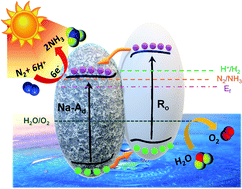Phase-selective active sites on ordered/disordered titanium dioxide enable exceptional photocatalytic ammonia synthesis†
Abstract
Photocatalytic N2 fixation to NH3via defect creation on TiO2 to activate ultra-stable N![[triple bond, length as m-dash]](https://www.rsc.org/images/entities/char_e002.gif) N has drawn enormous scientific attention, but poor selectivity and low yield rate are the major bottlenecks. Additionally, whether N2 preferentially adsorbs on phase-selective defect sites on TiO2 in correlation with appropriate band alignment has yet to be explored. Herein, theoretical predictions reveal that the defect sites on disordered anatase (Ad) preferentially exhibit higher N2 adsorption ability with a reduced energy barrier for a potential-determining-step (*N2 to NNH*) than the disordered rutile (Rd) phase of TiO2. Motivated by theoretical simulations, we synthesize a phase-selective disordered-anatase/ordered-rutile TiO2 photocatalyst (Na-Ad/Ro) by sodium-amine treatment of P25-TiO2 under ambient conditions, which exhibits an efficient NH3 formation rate of 432 μmol g−1 h−1, which is superior to that of any other defect-rich disordered TiO2 under solar illumination with a high apparent quantum efficiency of 13.6% at 340 nm. The multi-synergistic effects including selective N2 chemisorption on the defect sites of Na-Ad with enhanced visible-light absorption, suitable band alignment, and rapid interfacial charge separation with Ro enable substantially enhanced N2 fixation.
N has drawn enormous scientific attention, but poor selectivity and low yield rate are the major bottlenecks. Additionally, whether N2 preferentially adsorbs on phase-selective defect sites on TiO2 in correlation with appropriate band alignment has yet to be explored. Herein, theoretical predictions reveal that the defect sites on disordered anatase (Ad) preferentially exhibit higher N2 adsorption ability with a reduced energy barrier for a potential-determining-step (*N2 to NNH*) than the disordered rutile (Rd) phase of TiO2. Motivated by theoretical simulations, we synthesize a phase-selective disordered-anatase/ordered-rutile TiO2 photocatalyst (Na-Ad/Ro) by sodium-amine treatment of P25-TiO2 under ambient conditions, which exhibits an efficient NH3 formation rate of 432 μmol g−1 h−1, which is superior to that of any other defect-rich disordered TiO2 under solar illumination with a high apparent quantum efficiency of 13.6% at 340 nm. The multi-synergistic effects including selective N2 chemisorption on the defect sites of Na-Ad with enhanced visible-light absorption, suitable band alignment, and rapid interfacial charge separation with Ro enable substantially enhanced N2 fixation.

- This article is part of the themed collection: Most popular 2021 catalysis articles, 2021


 Please wait while we load your content...
Please wait while we load your content...